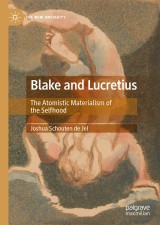Details

Blake and Lucretius
The Atomistic Materialism of the SelfhoodThe New Antiquity
|
96,29 € |
|
| Verlag: | Palgrave Macmillan |
| Format: | |
| Veröffentl.: | 23.11.2021 |
| ISBN/EAN: | 9783030888886 |
| Sprache: | englisch |
| Anzahl Seiten: | 266 |
Dieses eBook enthält ein Wasserzeichen.
Beschreibungen
<div>This book demonstrates the way in which William Blake aligned his idiosyncratic concept of the Selfhood – the lens through which the despiritualised subject beholds the material world – with the atomistic materialism of the Epicurean school as it was transmitted through the first-century BC Roman poet and philosopher Lucretius’ <i>De Rerum Natura</i>. By addressing this philosophical debt, this study sets out a threefold re-evaluation of Blake’s work: to clarify the classical stream of Blake’s philosophical heritage through Lucretius; to return Blake to his historical moment, a thirty-year period from 1790 to 1820 which has been described as the second Lucretian moment in England; and to employ a new exegetical model for understanding the phenomenological parameters and epistemological frameworks of Blake’s mythopoeia. Accordingly, it is revealed that Blake was not only aware of classical atomistic cosmogony and sense-based epistemology but that he systematically mapped postlapsarian existence onto an Epicurean framework.<br></div>
<p>Chapter 1: Introduction.- Chapter 2: The Epicurean and Lucretian Slur: Francis Bacon.- Chapter 3: The Epicurean and Lucretian Slur: Isaac Newton.- Chapter 4: <i>Simulacra</i> and the Selfhood.- Chapter 5: Urizenic <i>Phantasiae.- </i>Chapter 6: The Cosmic Chains of the <i>Machina Mundi.</i></p>
<b>Joshua Schouten de Jel</b> is a recent doctoral graduate from the University of Plymouth, UK. He is the author of articles on William Blake, Mary Shelley, and Jean-Jacques Rousseau.
<p><i>“Blake and Lucretius: The Atomistic Materialism of the Selfhood </i>belongs both to the new field of Romanticism and Science and to an older current of esoteric source studies in Blake. Schouten de Jel argues that a number of interconnected patterns of imagery by which the poet delineates the fallen world and its deficits, are drawn from Epicurean and Lucretian tradition, much of it as adopted or reshaped in European intellectual history of the 15<sup>th</sup>, 16<sup>th</sup> and 17<sup>th</sup> centuries. The book is a treasure-trove of scholarship. It both demonstrates the systematicity and consistency of Blake’s imagery and illuminates it, making us see familiar language in a novel and enriching context. Blake’s rocks, watches, revolutions and sunflowers take on a new saliency and a new halo of associations.”</p><p> <b>—Laura Quinney</b>, Professor of English, Brandeis University, USA<br></p>
<p>This book demonstrates the way in which William Blake aligned his idiosyncratic concept of the Selfhood – the lens through which the despiritualised subject beholds the material world – with the atomistic materialism of the Epicurean school as it was transmitted through the first-century BC Roman poet and philosopher Lucretius’ <i>De Rerum Natura</i>. By addressing this philosophical debt, this study sets out a threefold re-evaluation of Blake’s work: to clarify the classical stream of Blake’s philosophical heritage through Lucretius; to return Blake to his historical moment, a thirty-year period from 1790 to 1820 which has been described as the second Lucretian moment in England; and to employ a new exegetical model for understanding the phenomenological parameters and epistemological frameworks of Blake’s mythopoeia. Accordingly, it is revealed that Blake was not only aware of classical atomistic cosmogony and sense-based epistemology but that he systematically mapped postlapsarian existence onto an Epicurean framework.</p>
<p><b>Joshua Schouten de Jel</b> is a recent doctoral graduate from the University of Plymouth, UK. He is the author of articles on William Blake, Mary Shelley, and Jean-Jacques Rousseau.</p><p></p>
<p>This book demonstrates the way in which William Blake aligned his idiosyncratic concept of the Selfhood – the lens through which the despiritualised subject beholds the material world – with the atomistic materialism of the Epicurean school as it was transmitted through the first-century BC Roman poet and philosopher Lucretius’ <i>De Rerum Natura</i>. By addressing this philosophical debt, this study sets out a threefold re-evaluation of Blake’s work: to clarify the classical stream of Blake’s philosophical heritage through Lucretius; to return Blake to his historical moment, a thirty-year period from 1790 to 1820 which has been described as the second Lucretian moment in England; and to employ a new exegetical model for understanding the phenomenological parameters and epistemological frameworks of Blake’s mythopoeia. Accordingly, it is revealed that Blake was not only aware of classical atomistic cosmogony and sense-based epistemology but that he systematically mapped postlapsarian existence onto an Epicurean framework.</p>
<p><b>Joshua Schouten de Jel</b> is a recent doctoral graduate from the University of Plymouth, UK. He is the author of articles on William Blake, Mary Shelley, and Jean-Jacques Rousseau.</p><p></p>
Explores the Epicurean legacy in William Blake’s work Shows that Blake was deeply influenced by Lucretian materialism Offers new insights into the reception of Lucretius across Europe from the seventeenth century onwards
<p><i>“Blake and Lucretius: The Atomistic Materialism of the Selfhood </i>belongs both to the new field of Romanticism and Science and to an older current of esoteric source studies in Blake. Schouten de Jel argues that a number of interconnected patterns of imagery by which the poet delineates the fallen world and its deficits, are drawn from Epicurean and Lucretian tradition, much of it as adopted or reshaped in European intellectual history of the 15<sup>th</sup>, 16<sup>th</sup> and 17<sup>th</sup> centuries. The book is a treasure-trove of scholarship. It both demonstrates the systematicity and consistency of Blake’s imagery and illuminates it, making us see familiar language in a novel and enriching context. Blake’s rocks, watches, revolutions and sunflowers take on a new saliency and a new halo of associations.”</p>
<b>—Laura Quinney</b>, Professor of English, Brandeis University, USA<br>
<b>—Laura Quinney</b>, Professor of English, Brandeis University, USA<br>
Diese Produkte könnten Sie auch interessieren:

The Enigma of Good and Evil: The Moral Sentiment in Literature

von: Anna-Teresa Tymieniecka

309,23 €















